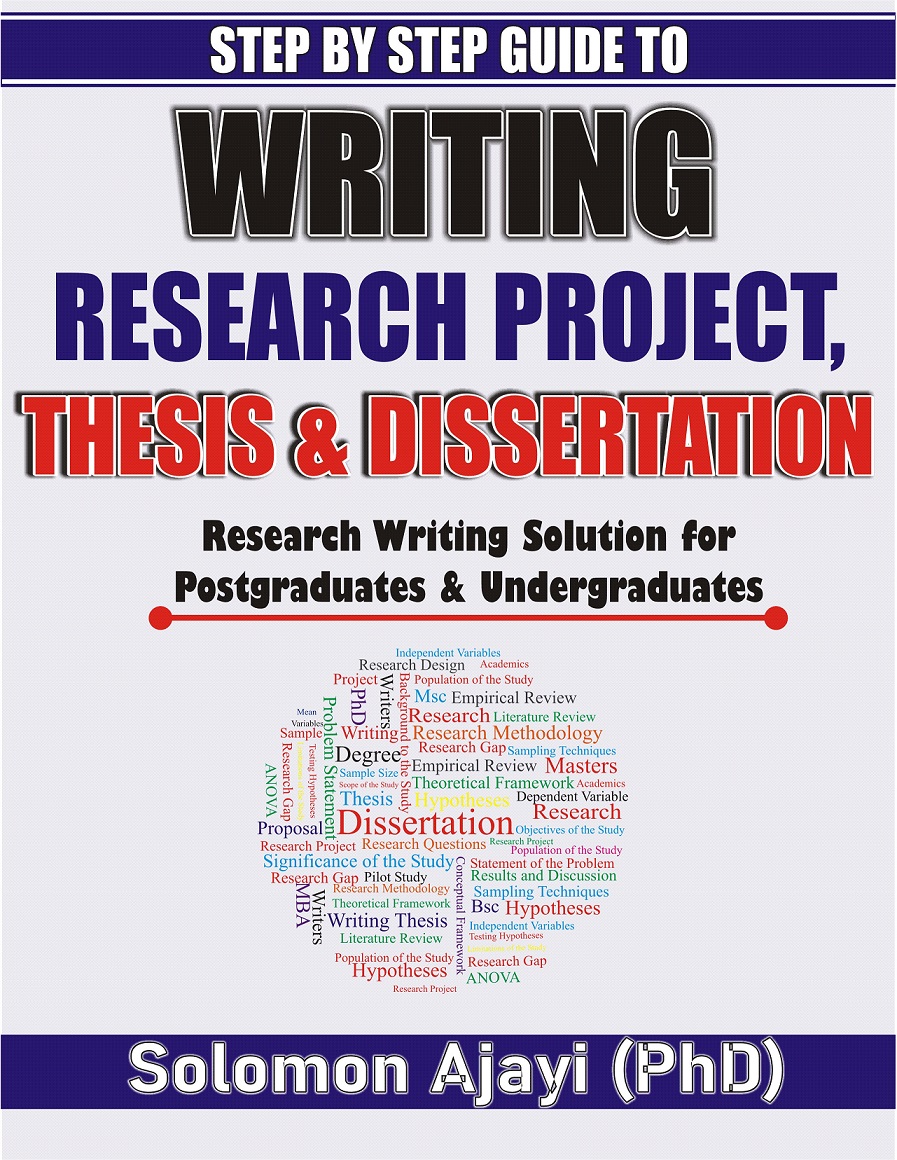
Project Writers in Nigeria BSc. MSc. PhD
Research Project Writing Website

HOW TO WRITE CHAPTER ONE OF RESEARCH PROJECTS

A PRACTICAL GUIDE TO RESEARCH WRITING – CHAPTER ONE
The outline of a well written Chapter One is supposed to include all or some of the following:
CHAPTER ONE
INTRODUCTION
1.1 Background to the Study
1.2 Statement of the Problem
1.3 Objectives or Purpose of the Study
1.4 Research Questions and /or Hypotheses
1.5 Significance of the Study
1.6 Scope and Limitation of the Study
1.7 Basic Assumptions
1.8 Operational Definition of Terms
As can be seen above, the project outline constitutes a huge part of the project proposal and the student researcher just needs to perfect the approved research proposal with the view of using it as the Chapter One. The fact remains that all the other parts that as had been written for the project proposal would still stand, with the inclusion of Operational Definition of Terms. At this stage, it is important to understand and know what is contained under each of the subheadings in the first chapter and these are described thoroughly in this article: –
1.1 Background to the Study
Just as the name means, this section outlines the history of the subject matter under investigation; the evolution of the research problem; how the researcher became fascinated with the problem. He goes on to describe the specific situation surrounding the research problem, using facts from the literature to support various arguments. In this section also, the student researcher tries to ascertain the suitability and feasibility of the study, concluding from the sufficient evidences drawn from the previous literature.
In a nutshell, this is where the student researcher initiates the subject of his investigation using all obtainable evidences and figures to establish its groundwork. Note that even if there is no standard number of pages that this should take, the lengthier and well focused the Background to the Study, the better for a good and solid groundwork for that research being conducted.
1.2 Statement of the Problem
The Problem Statement, as it is otherwise described, is the reasonable conclusion of the problems/issues raised in the Background to the Study. The idea is that while the Background to the Study offers a wider or global perspective/standpoint to the subject matter of the research, the Problem Statement makes assumptions from there and concludes on the specifics as they relate to the specific investigation being conducted.
That is the reason Problem Statement is expected to flow, rather logically, from the Background to the Study; and it is not a good Problem Statement, one that deviates from this; given that they are not expected to be two unconnected entities, as it were. It is nevertheless different from Background to the Study in that it must be stated reasonably briefly and very clearly. All the descriptive components of the Background to the Study would have assisted to allow one go straight for the specifics under the Problem Statement.
This is why experienced project supervisors would maintain that the Problem Statement should be in the range of one to three paragraphs only. The idea is that the shorter, the clearer; and the clearer the better for the whole process of investigation. In a nutshell, one cannot overstate the need to state the research problem very clearly and accurately, since the entire course of the investigation depends on it.
Therefore, there is no doubt that a satisfactory statement of the research problem is the most important component of a research process. The plain reason for this claim is that the whole process of investigation centers on it and it is typically related to some of the following issues:
- A missing link
- One-sidedness
- An unanswered question.
- An unsatisfactory state of arrangements
Consequently, the Problem Statement offers direction to the rest of the project; signifying and highlighting the major variables of concern to the researcher as well as the exact relationship that exist between them.
HIRE A PROFESSIONAL PROJECT WRITER

Best Research Writing eBook
Academic project or thesis or dissertation writing is not an easy academic endeavor. To reach your goal, you must invest time, effort, and a strong desire to succeed. Writing a thesis while also juggling other course work is challenging, but it doesn't have to be an unpleasant process. A dissertation or thesis is one of the most important requirements for any degree, and this book will show you how to create a good research write-up from a high level of abstraction, making your research writing journey much easier. It also includes examples of how and what the contents of each sub-headings should look like for easy research writing. This book will also constitute a step-by-step research writing guide to scholars in all research fields.
1.3 Objectives {Purpose} of the Study
Simply similar to every other component in a research project, the Objectives of the Study is strongly connected to the Research Problem. The former is derived directly from the latter. The Objectives of the Study, which is sometimes described as Purpose, stand for the aims of carrying out the investigation and could be categorized into general and specific.
The general objective describes the overall aim of a research project whereas the specific objective is concerned with the comprehensive list of intentions concerning what the research stands to accomplish at the end of the project. Typically, the specific objectives are stated in the form of declarative statements for example, the statement should start with “to examine”, “to analyze”, “to determine”, “to assess”, “to find out” etc. The Research Questions usually take the form of interrogative statement, the Objectives present the same thing, but in the statement form.
1.4. Research Questions and/or Hypotheses
Typically, these come immediately after the Research objectives because of their strong relationship. They do not just seek to convert the declarative statement of the objectives into interrogative form, but further break down the major problems compressed in the research objectives. As its name implies, Research Questions is presented just like interrogations seeking to create specific relations among the main variables of investigation.
As well, the Research Questions usually serve as the foundation from where the questionnaire items/questions would ultimately be derived. The difference between the two is that the items in the questionnaire offer a further breakdown of each of the research questions to a greater specification. This is to the level that a single research question can turn out the range of between three to five questionnaire items/questions. But the Research Questions are wide in nature, the questionnaire items are typically directed towards the details thereby getting down to more specifics.
In the case of Hypotheses, they are not the same as Research Questions even though they are sometimes used to substitute each other. In other words, it is not unusual to find projects which have both as well as others which have only one of them. Since they are not the same, they are not expected to replace each other. If they stand to do that, then one should be retained and the other disposed of. By this piece of information, one can easily know that it is not necessary that a project should have both; particularly at the elementary level, where in most of the times, the research questions would be okay.
By meaning, a Research Hypothesis is a clear, specific statement whose validity and workability can be tested by means of scientific method. Being a declarative statement of prediction, it tries to determine the relationship or difference that exists between one variable and the other; and to what degree. It is a form of clever guess or supposition regularly derived from the results of previous studies and/or theories originating from the literature. Hypotheses are formulated on the core of any of the areas and objectives listed below:
- To merely describe a occurrence or a statement of fact
- To compare two or more concepts, individuals and places
- To reveal the relationship between variable
- To reveal a cause/ effect situation between variables.
Usually, there are two kinds of hypotheses; basically referring to the way they are stated. They are the Null and the Alternative. While the former is frequently stated in the negative form of “No Significant Relationship” or “No Significant Difference” etc., the latter takes the positive form of statement; such as “There is a Significant Relationship”, “There is a Significant Difference” etc.
The Research Hypotheses specify the fundamental issues relating to the data to be gathered in the process of conducting the study. They serve as a theoretical conceptualization of what the researcher anticipated with respect to his research outcomes. These help him to test and verify his concepts on the basis of which he makes very tangible and reliable conclusions and generalizations. They also assist in sharpening researcher’s focus on the research problem with a view to determining the direction where to find the solution.
Therefore, some of the qualities of a good hypothesis must include that:
- It should be sensible {i.e. clever guesses}.
- It should be in line with known facts or theories.
- It should be constructed in such a manner that it is testable and found to be probably true or false.
- It should be in very simple, unambiguous terms.
- It should be directly connected to the problem of research.
- It should involve very few variables at a time.
- It should be quantifiable {i.e. operationally formulated}.
1.5. Significance of the Study
It is anticipated that every research project must have something new to contribute to knowledge in that research field, no matter how small. In point of fact, no research should take place if it will not contribute anything to knowledge; as this represents the major feature of all research endeavors.
Consequently, this section is expected to clarify the possible benefits of the research and to whom such anticipated benefits would be meant. All these should be clearly stated. In any way, there is no standard detail as to the number of benefits that a research project should have or its length. It can be arranged sequentially or itemized or paraphrased depending on the person’s method of writing.
1.6. Scope and Limitation of the Study
The scope of the study basically refers to the level of coverage of the research subject being investigated and the good statement of the problem will act as a helpful guide to doing this. That means, if the problem had been properly stated at the beginning, it helps, certainly, in defining the scope of the research. That is why the scope of the study is partially dependent on the title of the research project. If well formulated, the phrase of the title only does define the scope of the study and possibly, needs a little rider to make it clearer. The limitation of the study represents the things and issues that constituted challenges in the process of investigations.
Consequently, if the scope was concerned with the level of the research’s coverage, then, limitation implies building a fence around the subject of research. This is with a view to creating a foundation for the non-inclusion of certain things in the study for understandable reasons.
1.7. Basic Assumptions
Even though many student researchers tend to mistake Assumptions with Hypotheses, it is important to state very clearly that they are not the same. We have already discussed about hypotheses; its meaning and significance in a research project. However, Assumptions are only mere statements, which are frequently, not subjected to any testing. They are, more or less, ordinary statements that are taken for granted. They cannot replace the Hypotheses; yet, they tend to duplicate the Hypotheses, because they are fairly similar.
It is because of these reasons that a lot of research experts have suggested that if the study has hypotheses, then assumptions would no longer be needed. For a study with Research Questions only nevertheless, it is suitable to have assumptions, to act as a guide towards the achievement of the research objectives.
Assumptions are typically itemized while the number varies.
1.9 Operational Definition of Terms
This section of the Chapter one (introduction) is used to offer a kind of working definition to all the concepts, which would be operationally used in the course of the research. The notion is that there are some terminologies, which have been “adapted” and so utilized restrictively for the purpose of the research project.
This implies that such terminologies would mean something somewhat different from the one adapted under a different circumstances; therefore the name Operational Definition of Terms. In defining terms operationally, individual concepts/words to be so defined are recognized and then itemized. Thus, operational definitions are typically given in such a manner that will imply that they are not the usually accepted as standard definitions but those peculiar to the study in specifically. This section typically comes last in the introductory chapter.
Click here to get an expert project writer for your project topic on mzwriters.com
>>>>> HOW TO WRITE CHAPTER TWO OF RESEARCH PROJECTS
23 comments.
excellent write up, this should help me in writing my chapter one
Excellent write up. Great job, really helped me with my chapter one in my MBA project write up.
However I would like to know if I can add justification of study to my chapter one since you didn’t mention it in your post?
Great write up nevertheless!
Well thank you for the special guardian for my first chapter write up, however I wish if you break up background of the study into theoretical background, conceptual background and contextual background to make me have better analysis on how they are framed
Thanks a lot
This really helped me out to have an approach to good chapter one of my project. Thank you very much.
I realy apreciate your work here. This article helped me alot.
Do you have another one on chapter 2 (literature review)
Thanks. “how to write chapter two”, an article that will guide researcher on how to write the literature review will soon be published.
tanx,tanx,tanx this really help me when I wrotte my exam on research topic on my N.C.E program
Nice one, I haven’t started but I think this is really a nice guide for a start.
This is a great light to me. Thanks for the post
This is a well analysed research procedure….
Good work , well articulated, unambiguous, simply & logically stated.
Thanks for the write up… This should help me writing my project… Thanks once again.
GOD BLESS YOU
I am so glad with your work,l have gone through.l think what I benefited from it, will definitely guide me in my project work.so l am so grateful to you for making me to discover what I am looking for.
Thaaaaanks A good guide i’ll do a study on chapter one
Truth be told, I wish I had come across this write up before now. This is the clearest article I’ve read about contents of the chapters of a research project, especially chapter two. I’ve sent the link to my colleague PG Students.
Thanks so much.
it will great if you can add examples of what these when properly written will look like.
good guidance, keep doing so to help us learn better, together we stand
God bless you ?
Omo thanks a bunch
Good work done keep it up, i think your write up have helped me alot
Thank you,I do really appreciate and I learned more about.
Thanks very much, I have found this piece to he very educative and resourceful to any researcher.
This is the best foundation of Researchers
Leave a Reply
Your email address will not be published. Required fields are marked *
Chat With A professional Writer

- 99.1k views
- Planning to Write
Q: What do I include in chapter one of my research project?
Asked on 09 Sep, 2019
The introduction forms the first chapter or first section of any research project that you write, whether it is a project proposal, project report, thesis, or a journal article. Since you have used the word "chapter," I assume that you are referring to a project proposal/report or thesis.

Typically, chapter one of a research project proposal or thesis includes the following components:
- Study background
- Statement of the problem
- Purpose of the study
- Research question(s)
- Significance of the study
- Definition of terms
- Theoretical framework (not required for project proposal/report)
- Limitations of the study
- Basic assumptions
- Organization of the thesis (not required for project proposal/report)
For more detailed guidance, you can consider taking our course A simple guide on how to write a thesis .
Answered by Editage Insights on 23 Sep, 2019
- Upvote this Answer

This content belongs to the Conducting Research Stage
Confirm that you would also like to sign up for free personalized email coaching for this stage.
Trending Searches
- Background of study
- Scope of the study
- Types of qualitative research
- Rationale of the study
- Concept paper
- Literature review
- Introduction in research
- Under "Editor Evaluation"
- Ethics in research
Recent Searches
- Review paper
- Responding to reviewer comments
- Predatory publishers
- Scope and delimitations
- Open access
- Plagiarism in research
- Journal selection tips
- Editor assigned
- Types of articles
- "Reject and Resubmit" status
- Decision in process
- Conflict of interest

Hoortash Institute
Consultation writing, accepting and publishing articles
How to Write Chapter One; the Introduction of Thesis
How to Write Chapter One; the Introduction of Thesis. In “ Chapters of a Ph.D. and master’s thesis ” we discussed every five chapters of a thesis briefly. Now we are going to talk about chapter one deeper.
Chapter one of a thesis acts as a funnel. It begins with a broad subject related to the title of thesis, then narrows down to the variables and the questions/problems which are going to be solved in the research.
Generally, in introduction you need to explain what the reader is going to read about.
The introduction chapter has some subtitles which are:
- 1 Introduction
- 2 Statement of the Problem
- 3 The Significance of the Study
- 4 Purpose of the Study
- 5 Research Questions
- 6 Research Hypothesis
- 7 Definition of the Keywords
- 8 Limitations and Delimitations
You should adhere to the format of numbering subtitles.
Now take a look at the content of each section:
Introduction
In this section, introduce the subject you have studied. Start with the broad topic and limit it to the title of the thesis. By doing so, you establish your research territory.
Then provide some quotes or paraphrase other researches that emphasis on importance of the title. Show that according to other researches and papers there was a gap and you tried to fill that gap.

Statement of the Problem
Statement of the problem (SOP) has fiver smaller parts which are:
- Topic: in this paragraph you need to state the problem, from theoretical and practical points of view.
- Gap: state that this specific problem was not solved in previous researches.
- The evidence: write one or two paragraphs on some parts of other papers that the researcher indicates that the problem exists.
- Deficiencies: demonstrate that how you solved the problem and how the gap was filled.
- Audience: whom your study is precious to, and where it would be useful.
As you can see, SOP would be five to six paragraphs, and each paragraph has a clear aim.
Unlike the introduction section, you do not need to provide resources for every single statement in SOP, except for evidence section.
Note: remember that in the introduction you talked about the gap, too. There is a difference between the two gaps in SOP and in the introduction. The gap in the introduction is a broader gap, while in SOP you need to clarify it in details.
Significance of the Study
In this part, you should write in details. Prove that your study is significant for the major, other researches, and some other specific people related to the field of study (name them).
To do so, you may ask yourself these questions that how and why this study would be important.
Also usually the researchers state some gaps that they have found in the field during their research, in chapter five (conclusion) of papers and theses. You can use them as a proof of the significance of your study.
Purpose of the Study
State that by this research what you are looking for, and what you expect to reveal.
Research Questions
After a brief introduction, write down some questions which you aim to answer during your research.
In fact, the research questions are the same as the purpose of the study in the form of questions.
Research Hypothesis
In this section, answer to the research questions which are stated in the previous part.
For example, if one of the questions is “Is there any statistically significant relationship between TCK and IS of Iranian EFL learners?” then the hypothesis would be “There is no statistically significant relationship between TCK of Iranian EFL learners and their ICS.”
Only use null hypotheses.
Definition of the Keywords
Keywords are the variables of the thesis. Define them theoretically and operationally.
In order to write a theoretical definition, you need to scan related papers and find the definition of the keywords as they defined. Write several theoretical definitions quoted by several researchers.
After theoretical definition, open a new paragraph and state how the keywords are defined in your research. It would be called “empirical definition”.
Limitation and Delimitation
Every researcher face some limitation during the research process.
Limitation could be the limit number of samples, being a sample out of reach, and so on.
Limitation is out of researcher’s control, while delimitation is chosen by the researcher. For example, a researcher chooses to distribute the questionnaire among women, and not men.
Note that the explained format works in writing chapter 1 of proposals, too. The only difference is in the number of pages. Proposals have less number of pages in comparison to theses.

Questions and Answers about Writing Chapter One: The Introduction of a Thesis
What is the purpose of Chapter One: Introduction?
- Set the Stage: It introduces the reader to the research topic, providing necessary background information.
- State the Problem: It clearly defines the research problem or question that the thesis aims to address.
- Justify the Research: It explains the significance and relevance of the research, highlighting its contribution to the field.
- Outline the Structure: It provides a roadmap of the entire thesis, outlining the subsequent chapters and their content.
What are the key components of a strong Introduction?
- Engaging Introduction: Grab the reader’s attention with a compelling opening statement or a thought-provoking question.
- Background Information: Provide a concise overview of the relevant literature and research.
- Research Problem: Clearly articulate the specific problem or question that the research will address.
- Research Objectives: State the specific goals of the research.
- Research Questions or Hypotheses: Formulate clear and concise research questions or hypotheses.
- Significance of the Study: Explain why the research is important and how it will contribute to the field.
- Scope and Limitations: Define the boundaries of the research and acknowledge any limitations.
- Organization of the Thesis: Briefly outline the structure of the remaining chapters.
How can I write a clear and concise Introduction?
- Use Clear and Concise Language: Avoid jargon and technical terms unless necessary.
- Organize Your Thoughts: Create a logical flow of ideas, moving from general to specific.
- Use Strong Verbs: Use active voice and strong verbs to convey your ideas effectively.
- Proofread Carefully: Ensure that your writing is free of errors in grammar and punctuation.
When should I write the Introduction?
- After Research: It’s generally recommended to write the Introduction after completing the literature review and data analysis. This allows you to have a clear understanding of the research landscape and your findings.
How do I avoid common pitfalls in writing the Introduction?
- Avoid Rambling: Keep the Introduction focused and concise.
- Don’t Overstate the Significance: Be realistic about the impact of your research.
- Avoid Overusing Jargon: Use plain language whenever possible.
- Don’t Repeat Yourself: Avoid repeating information from other chapters.
Can you provide some tips for writing a strong thesis statement?
- Be Clear and Concise: State your main argument in a clear and concise manner.
- Be Specific: Avoid vague or general statements.
- Be Arguable: Your thesis statement should present a claim that can be supported with evidence.
- Be Relevant: Ensure that your thesis statement is relevant to your research question.
By following these guidelines, you can write a strong and effective Introduction that sets the stage for your entire thesis.
You Might Also Like

5 thoughts on “ How to Write Chapter One; the Introduction of Thesis ”
Thank you, bookwormlab for opening my eyes and telling me I should not limit my creative thought to just one essay, haha Since I started submitting my papers for editing and using the resulting texts as samples for my next assignments Amazing!
I got brief information about the aim of the theies.
Thank you so much
Howdy just wanted to give you a quick heads up. The text in your post seem to be running off the screen in Safari. I’m not sure if this is a formatting issue or something to do with browser compatibility but I figured I’d post to let you know. The style and design look great though! Hope you get the problem fixed soon. Kudos
Thanks I am gradually catching up. .right now I am writing my master thesis in liberia. Topic: An investigation into the cause and effect of untrained teacher in liberia schools. A case study at the E. J. Yancy high school 2019 to 2023
Leave a Reply Cancel reply
Your email address will not be published.
Save my name, email, and website in this browser for the next time I comment.

IMAGES
VIDEO
COMMENTS
A PRACTICAL GUIDE TO RESEARCH WRITING - CHAPTER ONE The outline of a well written Chapter One is supposed to include all or some of the following: CHAPTER ONE INTRODUCTION 1.1 Background to the Study 1.2 Statement of the Problem 1.3 Objectives or Purpose of the Study 1.4 Research Questions and /or Hypotheses 1.5 Significance
Figure 1. Conceptual paradigm showing the effect of mentoring program on the respondents AQ® as revealed by the Adversity Quotient Profile® Version 8.1. The main concern of this study is to explore the effect of mentoring program on the respondents' AQ®. The conceptual paradigm shows the process
This document outlines the basic format and components for chapter 1 of a research thesis. Chapter 1, called "The Problem", should include: a rationale providing background and justification; a theoretical framework discussing relevant theories; a conceptual framework outlining study variables and their relationships; a statement of the problem reflecting the research questions or hypotheses ...
Typically, chapter one of a research project proposal or thesis includes the following components: Study background; Statement of the problem; ... This content belongs to the Conducting Research Stage. Conducting research is the first and most exciting step in a researcher's journey. If you are currently in this stage of your publishing journey ...
1 . CHAPTER I: INTRODUCTION . The purpose of this qualitative grounded theory study was to identify what motivates women to stay in or return to science, technology, engineering, and math professions (STEM), leading to a motivation model. As illustrated in the literature review, research has
13. Parts of a Research Paper (Chapters 1-5) - Free download as PDF File (.pdf), Text File (.txt) or read online for free. This document provides guidelines for writing different chapters of a research paper, including the introduction, statement of the problem, theoretical framework, conceptual framework, assumptions, hypotheses, significance of the study, scope and delimitation, and ...
Chapter One of Your Thesis AED 615 Fall 2006 Dr. Ed Franklin Contents of Chapter One I ntr oduc i Background and Setting Identification of Problem Purpose Statement Objectives or Research Questions Assumptions LLi immit taatioonnss Definition of Terms Significance of The Study Introduction Section This is the first p assage in a dissertation ...
Now we are going to talk about chapter one deeper. Chapter one of a thesis acts as a funnel. It begins with a broad subject related to the title of thesis, then narrows down to the variables and the questions/problems which are going to be solved in the research. Generally, in introduction you need to explain what the reader is going to read about.
Provide a brief introduction linking what you presented in Chapter 2 to your research questions. Then list your research questions exactly as they were listed in Chapter 1. Method You should avoid "stacking" headings one of top of the other with no intervening text. Describe the nature of your study (e.g., mixed methods, quasi-experimental ...
1 Chapter I: Introduction to the Study This chapter makes a case for the significance of the problem, contextualizes the study, and provides an introduction to its basic components. It describes the research problem or research question and lays out the reasoning behind it.